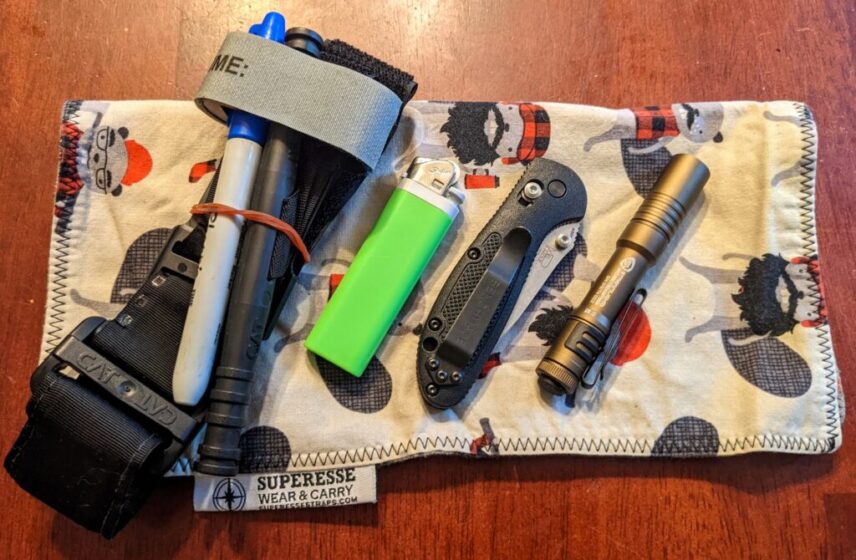
I saw a meme once that said something like, “If you’re counting on your cellphone flashlight after SHTF, you’re going to have a bad time.” The same sentiment carries over to your daily routine. Don’t count on tertiary convenience technology; cowboy up and start looking for the right tool for the task.
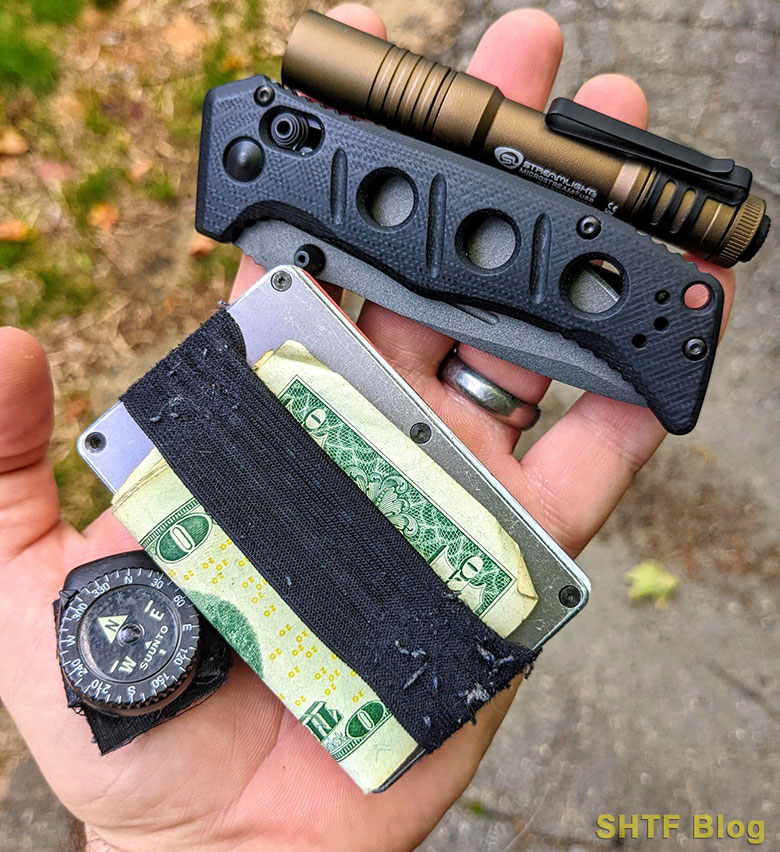 Don’t leave home without ’em! Suunto Clipper Compass, Ridge wallet, Benchmade Mini Adamas, and a Streamlight Microstream USB.
Don’t leave home without ’em! Suunto Clipper Compass, Ridge wallet, Benchmade Mini Adamas, and a Streamlight Microstream USB.
Without a bit of hyperbole, I can honestly tell all of you, dear readers, that carrying a flashlight with you every day is a life-changing experience – in a positive way. Until you have a small Every Day Carry (EDC) flashlight on your person on a daily basis, you really don’t realize how often you actually use that extra little bit of light.
Gotta look under the desk to plug the cell charger in? EDC flashlights are the tool for you. Blew a tire on a dark night without a streetlight in sight? EDC flashlights have you covered. Need some illumination to get you safely through a murky parking garage? EDC flashlights are your best friend.
What is an EDC Flashlight?
Simply put, EDC flashlights are an illumination tool you have on you all the time, every day. We’re not talking about a WW2 air raid spotlight here, folks – but rather, a tidy, smaller light that’s sized properly to not be obtrusive while wearing, but powerful enough for most daily tasks. It’s a good all-around light, perhaps not the best tool for every illumination job – but the good light you have on you is better than the perfect flashlight you left at home because it was too big.
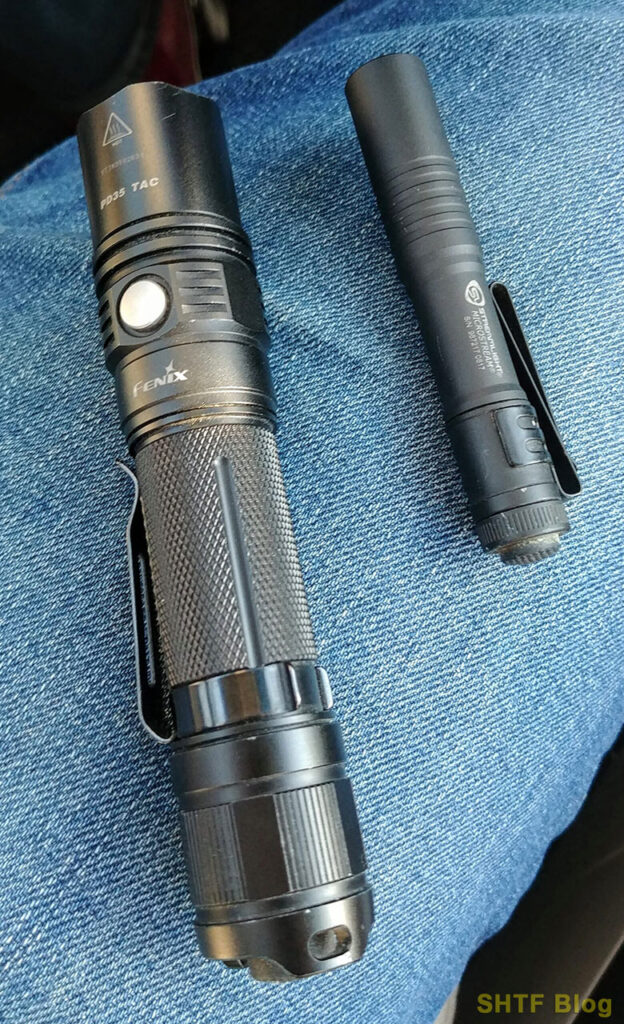 Big size differences are available for EDC lights. Here, a Fenix PD35TAC is shown next to a diminutive AAA-powered Streamlight Microstream.
Big size differences are available for EDC lights. Here, a Fenix PD35TAC is shown next to a diminutive AAA-powered Streamlight Microstream.
How to Choose an EDC Flashlight
Like buying a car or a firearm, choosing an EDC light is a personal choice based on individual need, routine, or situation; the flashlight a Wall Street broker might have on him every day is most likely not going to be the photon-blasting apparatus a Wyoming rancher would utilize.
Luckily, the flashlight market is astoundingly huge with a plethora of great (and, conversely, truly awful) products to choose from. To help you narrow it down, here’s what I’ve learned to look for over the past 30 years of carrying flashlights daily.
Cost
The spectrum of pricing varies widely with EDC flashlights, based on light manufacturer, reputation, quality, size, material, output, battery size…the list goes on. Personally, I try to stay under $50.00 since I have an alarming habit of losing EDC flashlights.
This high attrition rate is due to the fact that I usually buy smaller lights that are easy to misplace, or are light enough to easily slip out of a pocket when the clip catches on brush, clothes, jackets, etc. Fortunately, there are many fantastic EDC lights out there in my self-assigned price range. If you feel like spending more than $50, you can find some stellar lights; we’ll take a look at some of those too.
Quality
Aside from price (and honestly, more important to me than cost), the most important flashlight attribute for me is QUALITY. I make sure to buy from a well-known manufacturer and absolutely shy away from the gas station counter “12 LED” specials and Wal-mart endcap bulk pack lights.
After having a great many cheap, no-name lights fail on me (when you need a light, you NEED a light – and that’s when you find out your tool is broken), I at least buy my lights from a known manufacturer with a good-to-great name. If that means I shell out a few extra bucks, so be it.
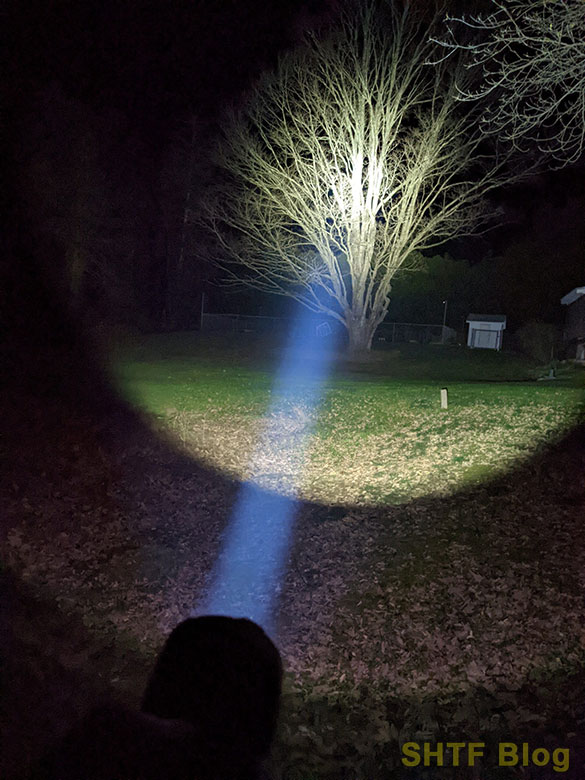 ALL THE LUMENS!! But are they really necessary?
ALL THE LUMENS!! But are they really necessary?
Lumens
When it comes to light, more is better, right? Not so fast, bucko. You may run into a situation where you need ALL THE LUMENS RIGHT NOW, but your EDC flashlight isn’t the best tool for the job at that point. With great lighting power comes drawbacks: a bazillion lumens blasted at your target will draw an incredible amount of battery power and will generate lots of heat, amongst other issues.
Many EDC lights are based on AAA or AA sized batteries; the small stature means low output and short battery reserves. A 1,500-lumen toast-maker will burn through a 900 mAh AA battery’s reserves in literally just a couple of minutes and will quickly make your light hot to the touch. For this reason, I generally like to keep my EDC light output to 100-250 lumens for most purposes.
I know, I know – just as how with automobiles, horsepower numbers sell cars, lumen figures sell flashlights. However, to have an EDC light with over 600 lumens or so may not be the best thing for run time on your light. Depending on the throw of the beam, 100 lumens is probably just fine for most normal purposes. For perspective: Do you recall those original incandescent bulb AA Mini Maglites? Those were a mere 35 lumens and they were considered amazing at the time.
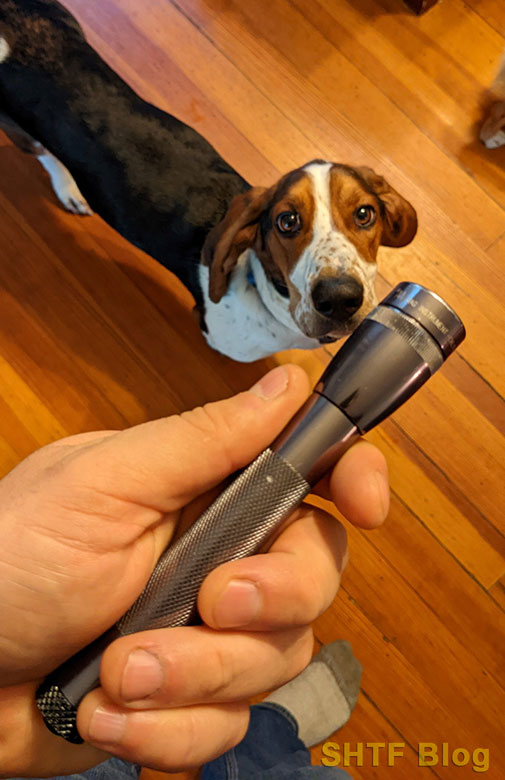 The tried-and-true Mini Maglites are still great utility flashlights. This one has been upgraded with a Nite-Ize LED kit. Basset Hound not included.
The tried-and-true Mini Maglites are still great utility flashlights. This one has been upgraded with a Nite-Ize LED kit. Basset Hound not included.
There are many modern flashlights that have a zillion modes and output levels; this is an option too if you like having extra buttons and multiple light levels to cycle through. There are even Laser Excited Phosphor flashlights now. Personally, for most of my EDC flashlights I just like a simple on/off switch and two output levels
Remember: You’re likely not going to be lighting up hillsides at a quarter mile with your EDC light; it’s meant to cover your needs for immediate, mundane purposes you may run up against every day. Err towards more conservative sizes and outputs and your battery life (and wallet) will thank you.
Size
Size is critical to the ECD flashlight. In my world, an EDC flashlight is clipped to a pocket, usually opposite to my pocket knife. This usually relegates the light size to AA or AAA sizes; for 95% of my routine, these smaller sizes are entirely adequate packages of performance and runtime.
Lights in the AA/AAA battery family are usually quite small, 3-4 inches in length and ½” to ¾” in diameter. I enjoy these smaller lights, as they don’t become an encumbrance or too big when clipped in your pocket. Also, if they’re being used clipped onto a baseball cap brim they’re not too heavy or too obtrusive.
However, If I’m heading out camping or if I’m heading into a location that I know to be a bit skeevy, sometimes I’ll grab a larger CR123- or 18650-powered lights and make the size tradeoff for the extra battery reserves and higher horsepower.
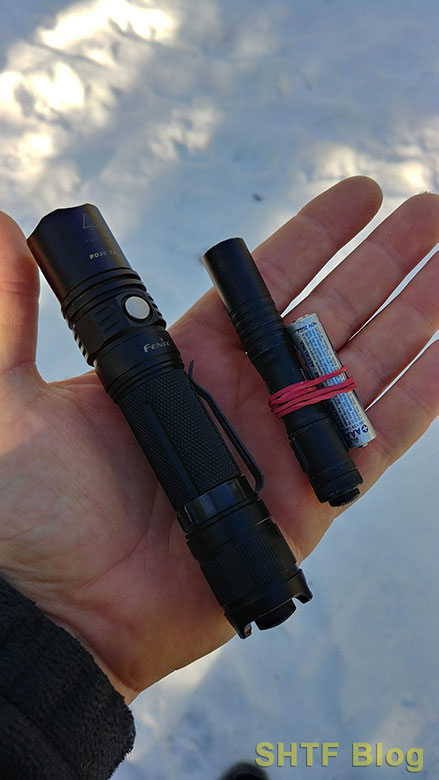 My Streamlight Microstreams often have a spare AAA battery affixed to them via rubber band.
My Streamlight Microstreams often have a spare AAA battery affixed to them via rubber band.
Battery
Since there’s no free cake in this world, there’s no easy answer as to which is the best-sized battery for an EDC flashlight. Flashlights are a personal choice – and what works best for me may not work best for Derrick James or, say, a Secret Service Agent.
As stated before, smaller batteries = less capacity. Larger batteries = more capacity. But no matter what battery size powers the EDC flashlight you run, there are a few things you can do to tip the odds in your favor:
Research and shop around. A bazillion and one companies make batteries these days. Do your due diligence and check for battery features, capacity, and output. Capacities will vary wildly depending on manufacturer and battery size. Try to stay away from the el cheapo no-name brands and stick with higher-end names like Surefire, Energizer, Fenix, and the like.
Buy Lithium Batteries. Lithium batteries are far more stable than other options, especially in the fields of battery life and cold-weather performance. Buying the right kind of battery will ensure your light maintains its charge and will be ready to go when you need it.
Buy Rechargeable Batteries. The ability to top off your light and walk out the door with a freshly charged battery is key. I usually buy a ton of EDC flashlight batteries and fully charge them and put them in storage. This ensures that I’ll have compatible, ready-to-go batteries if things go pear-shaped. Also, rechargeable batteries degrade over many charging/discharge cycles; when I notice a performance degradation, I will recycle the battery in the light and pop a new one in. Good to go.
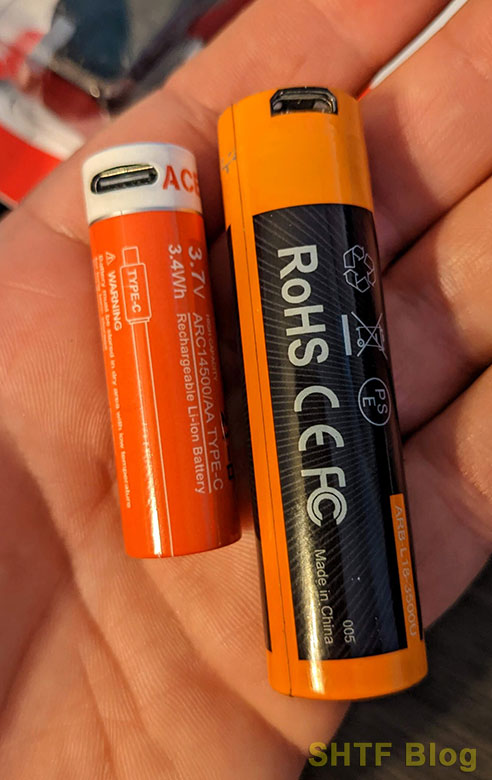 We live in magical times. These Acebeam and Fenix batteries have UBS ports built right in for recharging.
We live in magical times. These Acebeam and Fenix batteries have UBS ports built right in for recharging.
Also, make sure that any rechargeable batteries you get are compatible with any on-board charging systems you might have on your flashlight. If you’re not sure, buy a high-quality wall charger (The Acebeam A4 is my current favorite, pun intended) and use that to top off your batteries.
Also of note, come companies like Fenix are offering some batteries with built-in USB charging ports; these are slicker than snot on a glass doorknob and I fully endorse this technology.
Carry an Extra Battery! This simple solution to a lot of problems is a no-brainer. For smaller AAA sized EDC flashlights, I’ll often just rubber-band or electrical tape an extra battery right to the side of the light. For larger lights, I usually make sure I have a spare battery or three in my day pack or center console of my truck. Better to have it and not need it….
Features
There are some features I absolutely look for when buying an EDC light. It’s hard to find lights that encompass all of these features, so I look to these options as guidelines.
Rechargeability. I’ve touched on this already in the article, but we’re in the 21st century. Stuff is rechargeable. Embrace the technology. Use it. Love it. Flashlights today are rechargeable via one of three methods: integral solar panels (rare), integral USB port, or by utilizing rechargeable batteries.
All of these methods work superbly, with my favorite being the onboard USB port charging. No disassembly required; simply bring your flashlight to your personal charging station, solar cells, power bank, whatever – and plug it in. Simple and glorious. USB-rechargeable batteries work well for the same reasons, but have the downside that you must disassemble the light to retrieve the battery inside, upping the possibility that you lose, break, or misplace one of the light components.
Properly Designed Pocket Clip. I almost always wear my light clipped to my pants pocket when not in use. It’s convenient as all get out. However, the sheet metal clip that holds the light in place must be well designed. I had a Fenix LD02 AAA light that was absolutely lovely, but the pocket clip would consistently part ways with the body of the flashlight, flying across the room when it caught on something.
After dealing with that hullabaloo for far too long, the pocket clip eventually became completely lost to the ages and the light, now with 75% less utility, was relegated to the glove compartment of a truck that I sold. Good riddance.
A good pocket clip must be sturdy – they will have thousands of spring cycles over their lifetime as they’re used. The clip, if not permanently affixed to the body of the light, should go almost all the way around the light’s circumference, minimizing the possibility of it arbitrarily deciding to part ways with the EDC light.
I also usually search for two-way clips, so that the light can be clipped to your pants pocket, and can also be used as an ad hoc headlamp by affixing it to the brim of a baseball cap. Headlamp fanboys make fun of me when I do this, but in practice it works very well indeed.
Durability and Survivability. A weak-ass flashlight won’t cut it for me. I’ve had flashlights which were supposedly “drop rated” to survive falls from 3 meters break apart on me after a casual “oops” drop from waist level. Lights that were IPX7 rated (30 minute immersion up to one meter) flood themselves after I rolled a canoe in waist-deep water one frigid late April morning.
Another polymer-bodied light warped when I sat too close to a fire in a smelting shack. This doesn’t cut it. This is another reason why I try to steer myself towards quality manufacturer names and aluminum-bodied flashlights (sorry, Streamlight PolyTac, we had some good times together)
Less Features. These days, it seems that every high-end big dollar flashlight you buy has multiple function buttons, sliding parts, seven modes, and ridiculous options. In my years of experience, less is more. For simplicity’s sake, I prefer lights that have one button – usually just a tailcap switch – and a couple output levels – usually a low-power 5-50 lumen setting for close-in work like map reading and to save batteries, and a higher output level (100+ lumens) for everything else.
For my EDC light, I don’t need red LEDs, “turbo” settings, or useless strobes. Have you ever used a strobe function on a light? You? How about you in the back? No? I rest my case.
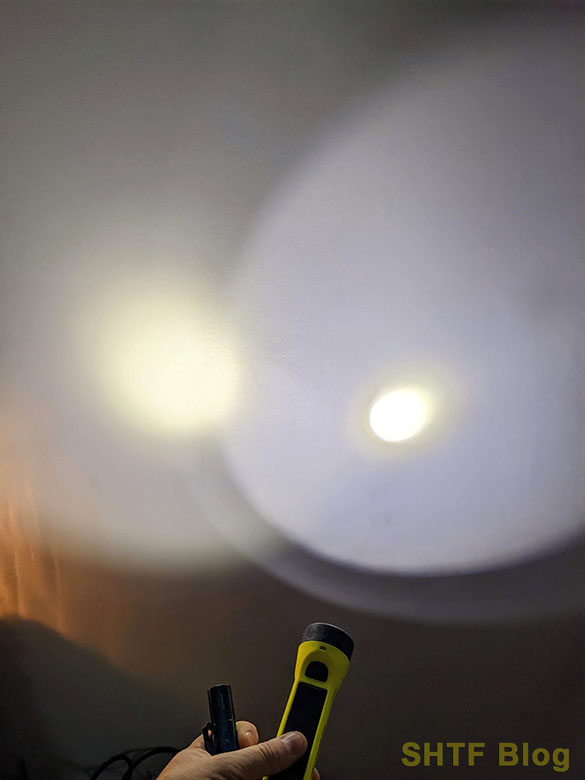 Two different beam styles at close range. Acebeam Rider RX on left, Hybridlight Journey 300 on right. Though the Hybridlight has 300 less advertised lumens, its more focused beam carries further. The Acebeam’s wider throw means it’s better at illuminating bigger areas close up.
Two different beam styles at close range. Acebeam Rider RX on left, Hybridlight Journey 300 on right. Though the Hybridlight has 300 less advertised lumens, its more focused beam carries further. The Acebeam’s wider throw means it’s better at illuminating bigger areas close up.
Beam Style – I really haven’t touched on my EDC flashlight preferred beam style, because well, you kind of get what you get. You can do your research and read reviews, but sometimes the options listed on the light will override the style of beam the light throws – which is kind of weird when you think about it; the beam the light throws is the entire reason for owning the light, right? At any rate, I trust the light designers to design the optimum photon delivery within the light’s designed purpose and capabilities…and they (usually) do a pretty good job.
I generally like a beam that’s more of a floodlight than a spotlight for my EDC lights, with large hotspots. EDC lights for me are usually used up close (within 6 feet or less) and a bright, focused beam in one place with no surrounding light spill is kind of the pits in my experience. Yeah, you can light up the bank on the other side of the Mississippi, but it’s just not as great when you’re searching the woods at night for the wallet you dropped and the main portion of your light throw is just a few inches wide at three feet.
So what are some of my favorite lights? Glad you asked! I’ll run through a few of the lights I like to use below, and throw in a couple others that qualified friends enjoy because they’re outstanding options.
Probably every single one of these lights has some attribute that flies in the face of the features list I’ve stated above. It’s hard to find that perfect light sometimes, even in today’s flooded market. Of course, your mileage may vary – and there are many, many other lights that aren’t listed below that may do the job better.
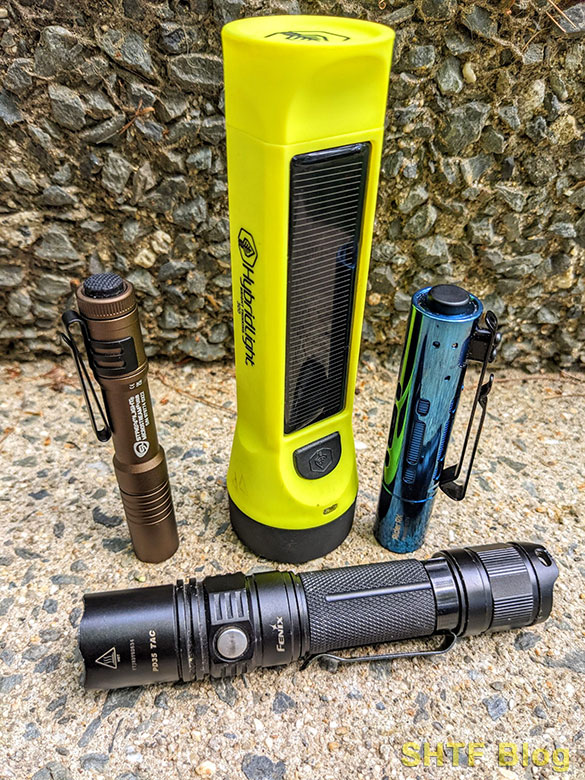 These are a few of my favorite things. And by “things” I mean “EDC Flashlights”.
These are a few of my favorite things. And by “things” I mean “EDC Flashlights”.
Best EDC Flashlights for Preppers
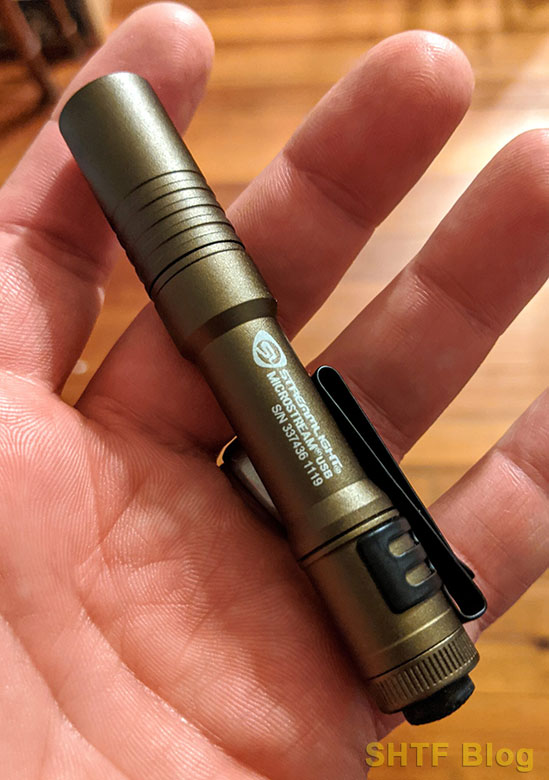 The Streamlight Microstream USB is a great choice amongst EDC flashlights!
The Streamlight Microstream USB is a great choice amongst EDC flashlights!
AAA Flashlight – Streamlight Microstream USB
I’ve been daily carrying some form of AAA-powered Streamlight Microstream for as long as I remember. Ever since I hung up my Mini-Maglite spurs, the diminutive Microstream has held a special place in my heart. My only – and I mean ONLY – complaint is that they’re so small, they end up easily lost.
The early Microstreams were great but lower-powered, with outputs in the 75 lumen range and just an on/off switch. Today’s Microstream USB features a 50 and 250 lumen settings that are accessible via a tailcap switch, and a O-ring sealed sliding sleeve that reveals/covers an integral mini-USB charging port.
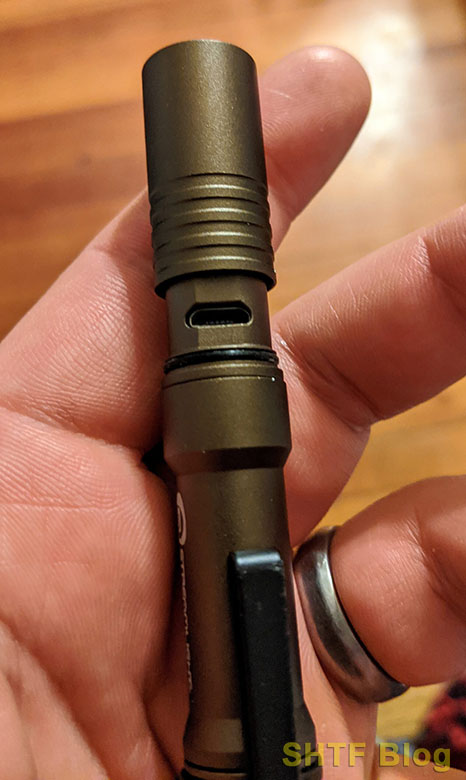 The Streamlight Microstream USB’s collar slides to reveal an O-ring-sealed USB port for recharging.
The Streamlight Microstream USB’s collar slides to reveal an O-ring-sealed USB port for recharging.
At around $30-35 bucks a pop, these lights are absolutely no-brainers. Streamlight quality and customer service at a great price point and killer performance level. I carry one of these with me every day, everywhere.
AA Flashlight – Acebeam Ryder RX
Yeah, I know the AA battery-powered field has some absolutely superb illumination tools, and I’m saying that a Chinese light from a company you probably haven’t heard much about is better than a Streamlight ProTac or a Fenix A12? Well, yes and no. What makes the Acebeam Rider RX appealing is a unique feature set and performance.
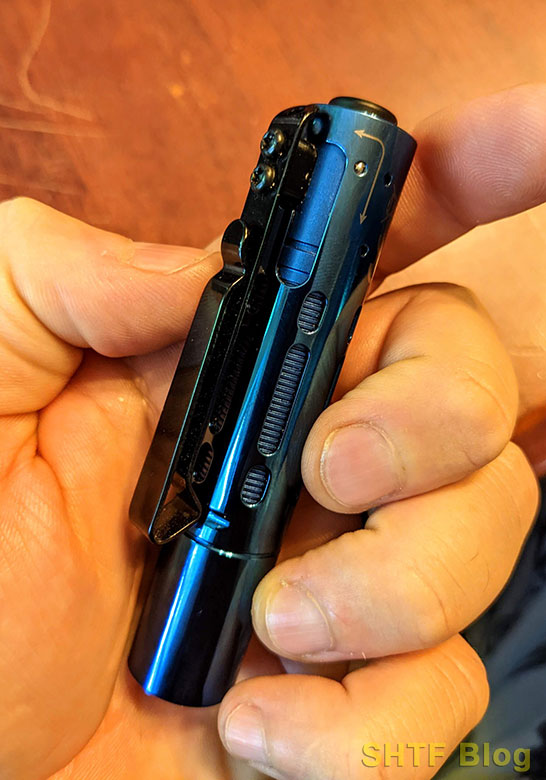 Rugged, powerful, and…blue? The Acebeam Rider RX won me over.
Rugged, powerful, and…blue? The Acebeam Rider RX won me over.
Acebeam originally sent this light to me some time ago for a review (I’ve reviewed other Acebeam lights here – they’re quite good), and I really didn’t give it too much of an honest college try. However, when I lost a Microstream one day, I needed an EDC light, and the Rider RX fit the bill (I thought temporarily). But after several weeks of daily carry, I have to begrudgingly give the tough little Acebeam its due props and tip of the hat.
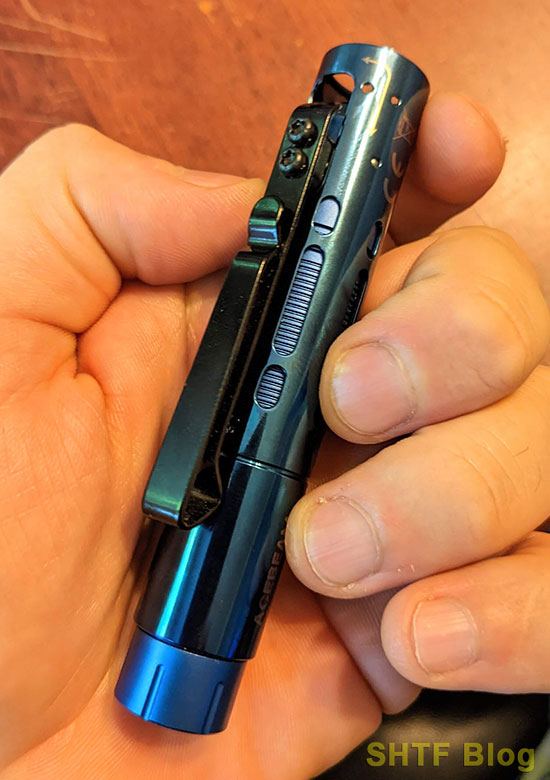 A flick of the “fidget”clip, and the bezel extends out of the stainless steel sleeve.
A flick of the “fidget”clip, and the bezel extends out of the stainless steel sleeve.
You see, the Acebeam Rider RX sports a lightweight but strong sliding stainless steel sleeve that covers the entirety of the main body of the flashlight (which is made of machined aluminum). Acebeam markets this feature as a type of a bolt-action fidget tool, giving idle hands something to do with one of their EDC flashlights. However, the sliding sleeve is more than that.
It provides an outstanding primary protection barrier for the light, as well as a heat insulator. It keeps all the bits and pieces of the light tucked away and recessed, ensuring that any drops or wayward flying debris short of bullets will be handily deflected. The sleeve also lets the light slide outward, drawing the tailcap switch up inside, and then allowing the light to tailstand and illuminate an area – a feature that many EDC lights can’t seem to be able to do.
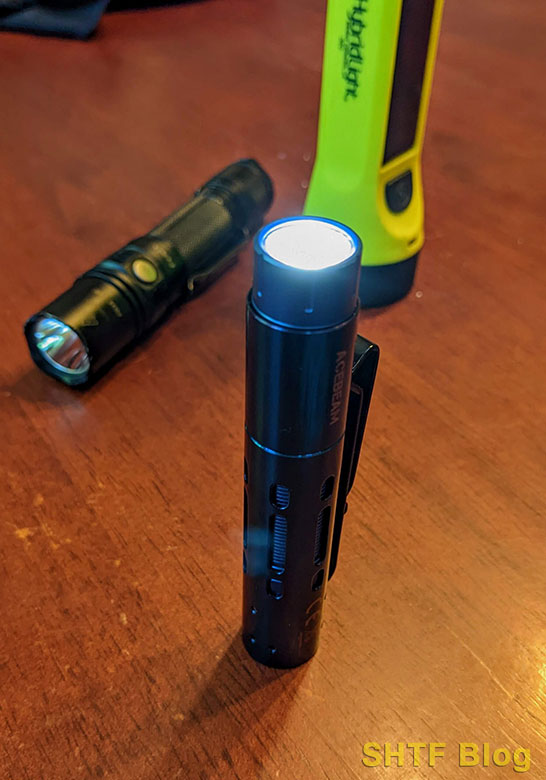 Does your EDC flashlight tailstand to illuminate a room? The Acebeam Rider RX does.
Does your EDC flashlight tailstand to illuminate a room? The Acebeam Rider RX does.
Rounding out the list is an impressive performance roster you can’t ignore: 650 lumens at full tilt, with a couple output gradients down to a 7 lumen “moonlight” mode that sips juice from its supplied USB-C rechargeable 920 mAh 14500 battery.
These are great little lights, superbly tough. When my boy needs a light to go and romp around the woods with, I hand him the Rider RX. I know it’ll get back in one piece. At $50 from Acebeam, it’s not what I would consider an inexpensive light, but its performance and sturdiness make it a winner at this price point for sure.
CR123/18650 Flashlight – Fenix PD35TAC
I bought my FenixPD35TAC years ago (so long ago, Fenix has actually upgraded the light design with a 2.0 and 3.0) to use as a weapon-mounted light on a rifle build. I bought the pressure switch, light mount, the whole shebang. However, when I utilized the Fenix, I always kept wondering why I kept this light on a gun and hardly used. So I pulled the PD35 off the rifle, replaced it with another light system, and haven’t looked back.
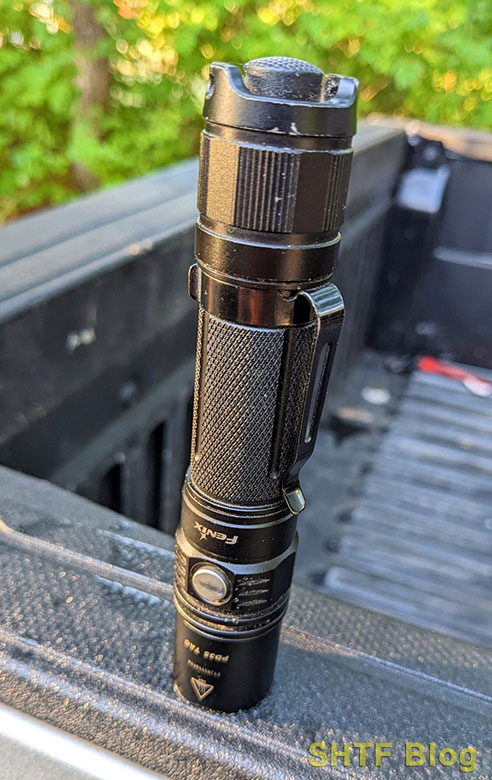 BEHOLD – the mighty Fenix PD35TAC – one of this author’s longtime favorite EDC flashlights.
BEHOLD – the mighty Fenix PD35TAC – one of this author’s longtime favorite EDC flashlights.
The Fenix PD35TAC is my go-to “heavy” light for when I know I’ll need more horsepower in the light-emitting department. Just barely skirting the outside edges of what I would consider to be “pocket sized”, the PD35TAC does indeed get carried clipped in my pants pocket. Its size means it can carry huge rechargeable 18650 batteries (I bought the light before Fenix started putting onboard USB ports for recharging) for lots of battery capacity on tap.
I’ve bought a ton of Fenix’ 18650 USB rechargeable batteries, and a 3,500 mAh battery lives in the light on a permanent residence. In a pinch, I have backup batteries, and the Fenix can run off the same CR123A batteries that power all my Streamlight TLR-1s and ProTac Rail mount lights, simplifying my battery logistics.
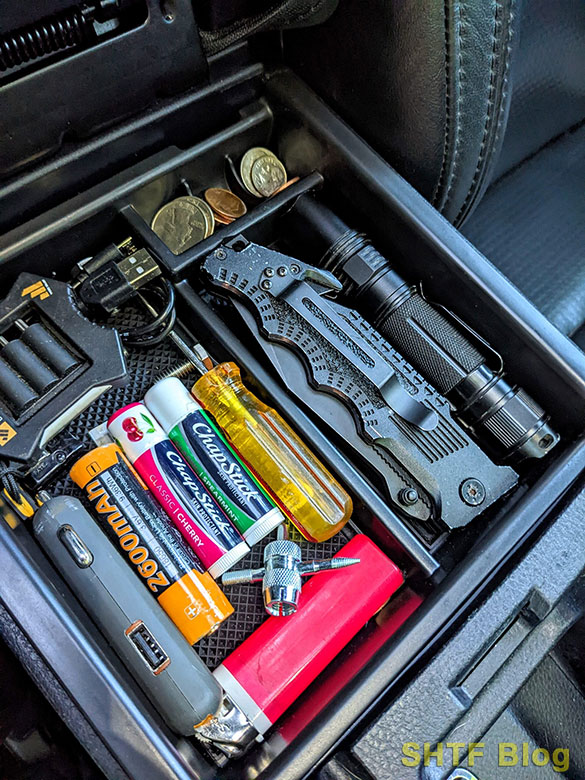 The Fenix PD35TAC fits perfectly in this Toyota Tacoma’s center console tray.
The Fenix PD35TAC fits perfectly in this Toyota Tacoma’s center console tray.
The Fenix PD35TAC sports a respectable 1,000 lumens of nicely directed light on its highest setting, and a side-mounted button can toggle between 8, 60, 200, 500, and 1,000 lumens. Mine usually lives on the 200 lumen setting, which is very friendly on battery life while providing useful illumination for most duties.
This Fenix has been around the block with me over the years – banged, soaked, dropped, used and abused hard. It’s an absolutely dynamite light, and I will be very sad indeed the day it gives up the ghost.
Bug-Out Bag Light – Hybridlight Journey 300
Less than 40 bucks will net you the most badass outdoors flashlight you could want. The Hybridlight Journey 300 may not be a pocket flashlight, or have clips or tailcap switches or doodads or removable batteries, but it is indeed a formidable light tailored for use in your bug out bag and car glovebox.
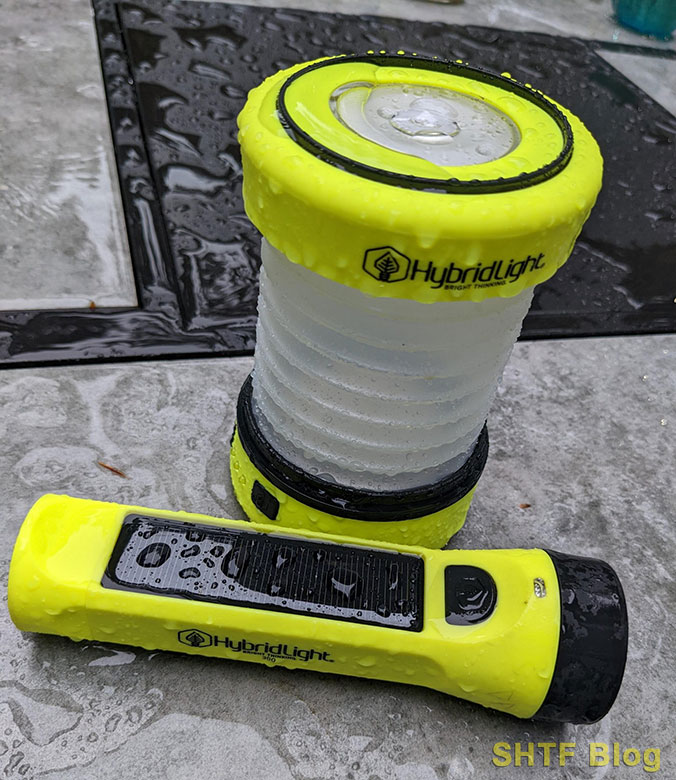 As far as outdoor illumination goes, Hybridlight is almost impossible to beat. The Journey 300 flashlight (bottom) rocks.
As far as outdoor illumination goes, Hybridlight is almost impossible to beat. The Journey 300 flashlight (bottom) rocks.
You see, the Hybridlight Journey 300 sports an integral and very functional solar panel set into the body of the light. This panel charges an integral and sealed 2,500 mAh lithium-ion battery that will hold its charge for 7 years. The system works superbly and is very well thought out.
Instead of a tailcap switch, Hybridlight engineered a waterproof O-ring sealed cap that unscrews to reveal two USB ports: one micro-USB to fast-charge the Journey 300 if you don’t want to wait for the solar panels, and a USB to use the Journey 300 to charge other devices! You can use it to charge your phone in times of emergency or whenever you need a top-off.
And no worry about leaving yourself without a light if you have to plug your phone in; the Hybridlight shuts off the charging function when 20% of battery life remains, ensuring that you’ll still have some illumination when needed.
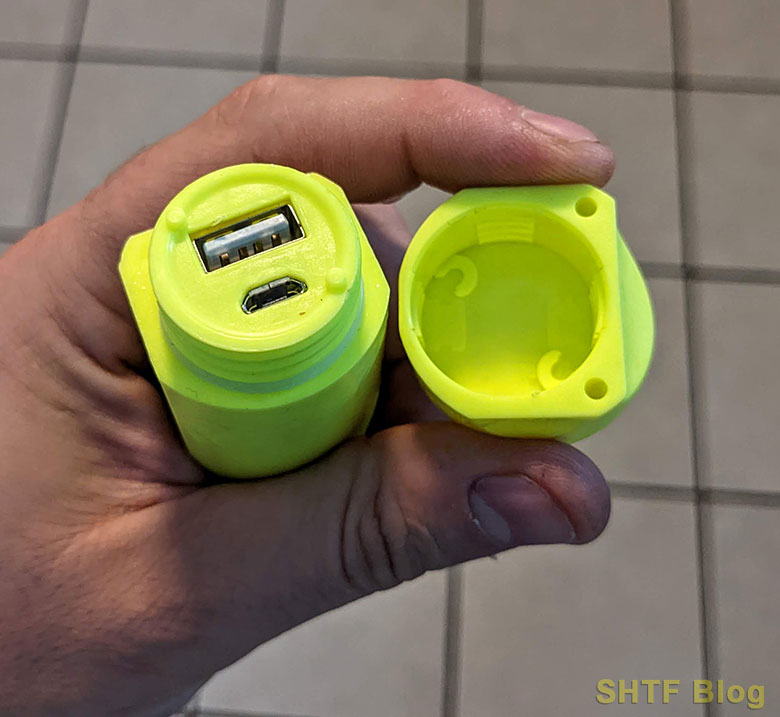 USB Ports are built into the tail of the Hybridlight Journey 300, allowing you to fast-charge the flashlight or use the light’s battery to charge other devices. Genius!
USB Ports are built into the tail of the Hybridlight Journey 300, allowing you to fast-charge the flashlight or use the light’s battery to charge other devices. Genius!
The Hybridlight Journey 300 floats and is waterproof, is just about impervious to most damage, and its single function button toggles between low (50 lumen) and high (300 lumen). The light is a bit too cumbersome to really call it an EDC light, but you can bet your bottom dollar (or forty dollars) you’ll be carrying it and loving it every day in an emergency, camping, or outdoors situation. Get one. Get two. Get ten. They’re that good.
Best EDC Light with Most Convenient Charging System – Olight Warrior 3S
If you’ve been following along on our light reviews, you’ll recall that the entire line of Olight flashlights comes with a convenient charging system. They’ve sent us SHTF Blog writers countless lights over the years, and the same USB charging cables work across (almost) all of their lights, whether it’s EDC lights, tactical weapon lights, duty lights, or battery-powered “Olanterns.” One magnetic charging cable is capable of charging many Olights.
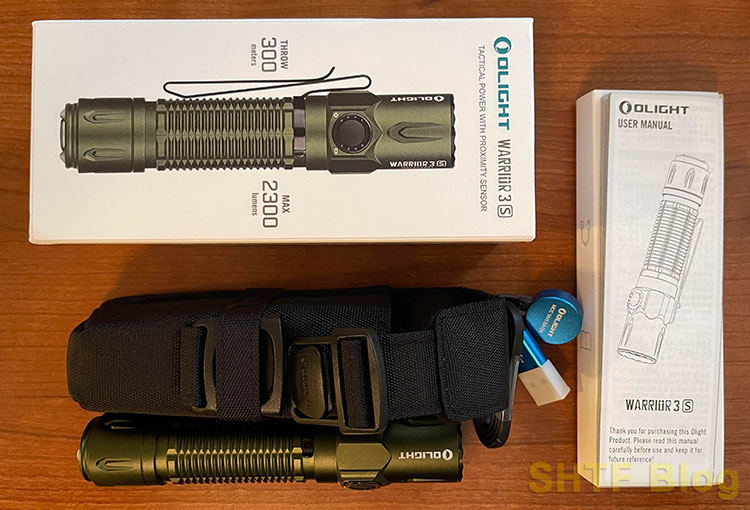
If you’re shopping at Olight, use coupon code “prepperpress” for additional savings
(excludes sale items).
The Warrior 3S is a robust light that builds off Olight’s successful Warrior series of lights. This particular model delivers up to a jaw-dropping-for-its-size 2300 lumens. The extra long run time (at its lowest setting) makes it useful for many different activities, consistent with everyday carry lights.
Unique to the Warrior 3S is its innovative proximity sensor. If you are shining a light on an object and the light is on a higher setting, as you move closer the light will automatically sense the increasing proximity and decrease the power of the light so that it’s not overpowering. This makes the light particularly useful when you are working on projects that require you to move to and from the items you’re working on. I particularly appreciate this feature when reading maps in the dark – you don’t get your retinas blasted out when shining the Warrior 3S on a light-colored map if you accidentally left it on a high-output setting; the light recognizes the brightness and automatically throttles back the output. Pretty spiffy.
The Olight Warrior 3S’s integral aggressive knurling is fantastic if you have wet hands or gloves on, and the tiny indicators adjacent to the output select button conveniently show you the output level and battery charge level.
The light also comes with a carry case (Olight labels it a holster) for belt- or pack-carry EDC fucntions, an alternative carry clip if you want to carry the light in your jeans pocket, and it can be connected to Olight’s pressure switches and mounted on a firearm. This makes an EDC light that doubles as a tactical light – versatile!
What Type of EDC Flashlights do Serious Users Carry?
I asked a couple police buddies of mine what they use for their EDC Flashlights. My thought process is that not many jobs demand a flashlight to work all the time, every day as much as a police officer’s. Both officers said their lights get used HARD, and many flashlights don’t make the grade.
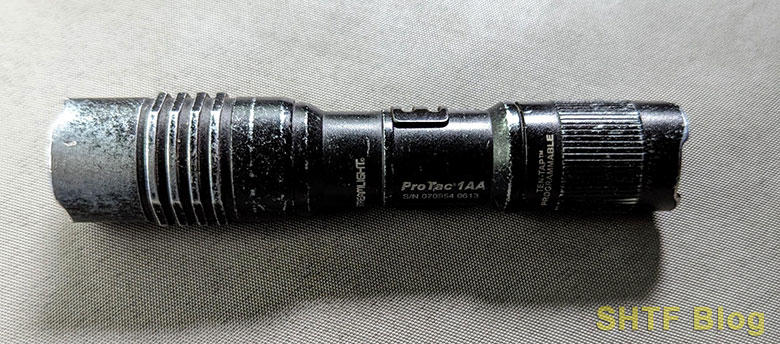 A well-used but still functioning Streamlight ProTac 1AA – police officer’s EDC flashlights get used hard and need to work every time!
A well-used but still functioning Streamlight ProTac 1AA – police officer’s EDC flashlights get used hard and need to work every time!
While his issued duty flashlight is a superb Streamlight Stinger DS, He uses a Pelican 1910 AAA Battery for most light-duty work and most unobtrusive off-duty EDC carry. A diehard believer in the “Two is one and one is none” mindset, he also carries a Streamlight ProTac 1L-1AA for some heavier lifting. He states, “The Streamlight is a bit bigger, but can handle everyday tasks and is capable to augment the pistol, so I usually carry that. But the Pelican is very nice for a low-profile general task light.”
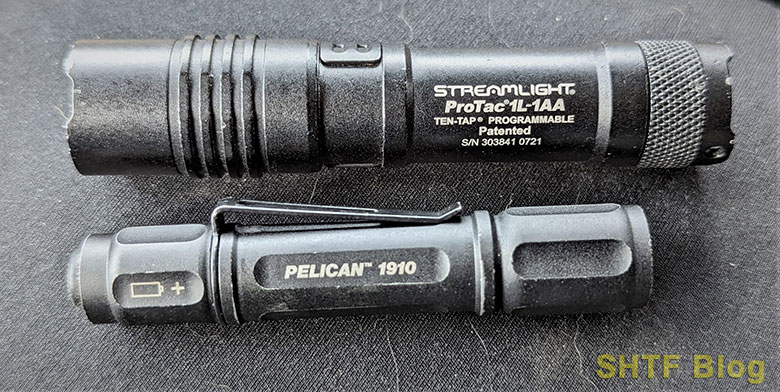 Streamlight ProTac 1L/1AA and a Pelican 1910 – proved by policework to be great EDC flashlights.
Streamlight ProTac 1L/1AA and a Pelican 1910 – proved by policework to be great EDC flashlights.
Another police buddy from further south says that in his department, the officers all have their choice of EDC Flashlights to use, but he chose Streamlight (noticing a pattern here?) and uses a Streamlight ProTac HL-X for all of his illumination needs. Why? It works. All the time.
Wrapping It Up
An EDC Flashlight is a powerful tool that you’ll learn to appreciate very quickly. Though you can go as wild and blistering as you want, you don’t need to have a crazy hot-rodded light blaster to fulfill most of the tasks you’ll run up against in your mundane day-to-day routine. Though I always keep a more capable light nearby, the EDC light gets used practically every day and has become an absolutely indispensable tool that I just won’t leave home without.
EDC lights are incredibly personal, and so I would love to hear your thoughts on what you carry for an EDC flashlight and why. Sound off in the comments below!!

